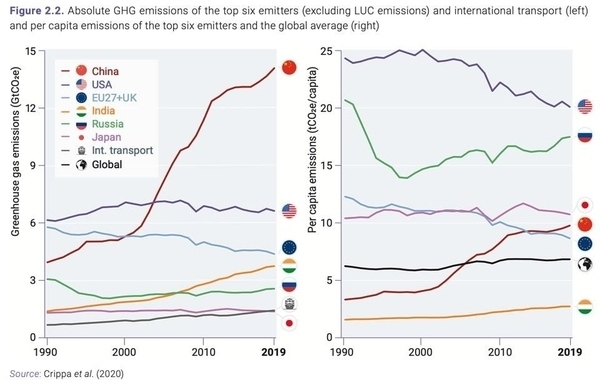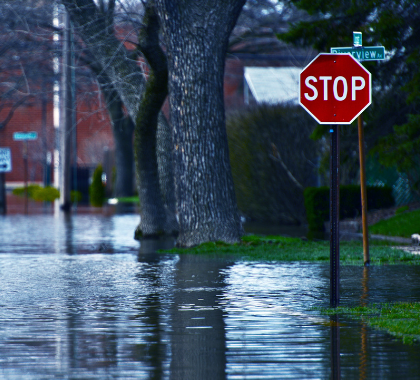In less than a month, three separate reports have been released repeating the same half-truth: the costs of natural disasters are rising, setting records in recent years, and human-caused climate change is to blame. I say half-truth because it is also a half-lie.
Each of the studies received copious amounts of prominent coverage by the mainstream media. I suspect the timing of the releases and the coordinated coverage were not by coincidence. They were intended to gin up a steady drumbeat of support for radical climate action by the incoming Biden administration, with these studies intended to provide the new president’s climate team with justification and cover for a “great reset” type of takeover of the economy to save the world from apocalyptic climate change.
It is true the costs of natural disasters have risen in recent years. However, real-world data indicate climate change, whether human-caused or not, bears little if any blame for that fact. Instead, people’s choices about where to live and work, and government policies that create moral hazard, are to blame for the higher costs from floods, wildfires, and storms.
In late December a group calling itself Christian Aid released a report titled “Counting the Cost 2020: a Year of Climate Breakdown,” which attributed the high costs of the year’s 15 most expensive weather-related disasters to climate change. A week later, the giant German reinsurer Munich Re released “Record Hurricane Season and Major Wildfires—The Natural Disaster Figures for 2020.” The reinsurer’s report said natural disasters, including hurricanes, flooding, and wildfires, “produced losses of US $210 b[illion], with insured losses of US $82 b[illion]” worldwide. The reason for the high costs, Munich Re asserted, was that human-caused climate change made natural disasters worse. On January 8, the National Oceanic and Atmospheric Administration (NOAA) published a report claiming there have been 285 climate-change-enhanced natural disasters since 1980, imposing costs exceeding $1.875 trillion, and the United States experienced 22 weather- or climate-related events in 2020 alone topping $1 billion in costs (a new record).
The costs of natural disasters have risen considerably over the course of the past century (with its modest warming), but long-term data indicates there has been no increase in the number or severity of natural disasters in recent decades. In fact, 2020 was not unusual historically.
Long-term data show the number of wildfires and acreage consumed by them has declined dramatically over the past century. On top of that, the Copernicus Atmosphere Monitoring Service reports, “2020 was one of the lowest years for active fires globally.”
NASA recently reported its satellite measurements show wildfires globally declined by 24 percent since 1998, and the total global amount of area burned annually declined by more than 540,000 square miles, from 1.9 million square miles in the early part of twentieth century to 1.4 million square miles today.
The data on hurricanes is equally clear. The United Nations Intergovernmental Panel on Climate Change reports there is “only low confidence for the attribution of any detectable changes in tropical cyclone activity to anthropogenic influences.” Data from the National Hurricane Center (NHC) shows hurricane impacts in the United States have been at an all-time low in recent years.
“The United States recently went more than a decade (2005 through 2017) without a major hurricane measuring Category 3 or higher, which is the longest such period in recorded history. The United States also recently experienced the fewest number of hurricane strikes in any eight-year period (2009 through 2017) in recorded history,” notes Climate at a Glance: Hurricanes.
A recent Climate Realism article notes Ryan Maue, NOAA’s chief scientist, reported global Accumulated Cyclone Energy (ACE), a measure of global hurricane power, has trended slightly downward over the past 30 years.
Each of the three recently released climate disaster cost studies ignores or downplays what Bjorn Lomborg, in his book False Alarm, refers to as the “expanding bullseye effect.” The increased costs of natural disasters in recent decades have been caused by communities increasingly expanding into areas historically prone to natural disasters, such as flood plains, forests, and coastal areas, and erecting increasingly expensive structures and infrastructure there. As a result, when extreme weather events strike, more developed land and more expensive properties are damaged.
Inflation also contributes to higher reported dollar losses in 2020 than in 2010, 2000, 1990, or in the early 1900s, when disasters killed many more people but did much less damage to property, in dollar terms, than today. A recent Climate Realism post noted in its title, “After 100 years of climate change, ‘climate related deaths’ approach zero.” You read that right. Though you won’t see the good news reported by the mainstream media, lives lost to natural disasters have declined by almost 100 percent over the past century-and-a-half during the recent period of warming. This is attributable largely to economic growth, which has allowed societies to monitor disasters better and to adopt policies and adaptive technologies that reduce deaths and injuries.
It is also worth noting that although the absolute dollar cost of natural disasters has risen because of inflation, the expanding bullseye effect, and economic growth, real economic growth has increased faster than has the real cost of natural disasters. As a result, the cost of natural disasters measured as a percentage of Gross Domestic Product has also fallen over time and should continue to do so.
Government has also contributed to the rising costs of natural disasters through various subsidized government-backed or -operated disaster insurance programs and emergency declarations leading to low-cost or no-cost loans. As I detailed in a study earlier in my career, a host of government programs reduce individuals’ responsibility for decisions they make about where to live and work. For instance, the U.S. Army Corps of Engineers (Corps) flood control program, federal flood insurance, and Corps beach replenishment projects subsidize construction in flood-prone areas, encourage high-risk development, and harm environmentally sensitive areas. Federally backed hurricane insurance provides the same perverse incentives for people who want to live near a beach. The Heinz Center has determined that without these insurance and flood control programs, development density in areas at high risk of flooding would be about 25 percent less than in low-risk areas.
Each of the studies released recently is demonstrably wrong in linking the higher costs of natural disasters to purported human-caused climate change. They certainly provide no justification for stampeding the United States into taking extreme actions such as banning fracking or ending the use of fossil fuels to generate electric power or for transportation, as the Biden administration has said it wants to do.
If Biden truly wants to reduce the damage that results when natural disasters strike, his administration could remove the incentives the federal government provides and policies it has developed that encourage people to live and work in places historically at risk from natural disasters. This would prevent far more harm in the years ahead than any effort to restrict carbon-dioxide emissions.
— H. Sterling Burnett
SOURCES: National Oceanic and Atmospheric Administration; Munich Re; Christian Aid; Climate Realism; False Alarm; Liberty and Ecology; National Center for Policy Analysis
IN THIS ISSUE …
GOVERNMENT PURGE OF CLIMATE SKEPTICS HAS BEGUN … U.S. LEADS THE WORLD IN EMISSIONS REDUCTIONS, REPORTS U.N. … HURRICANE, TORNADO ACTIVITY BELOW NORMAL, TRENDING DOWNWARD
GOVERNMENT PURGE OF CLIMATE SKEPTICS HAS BEGUN
Kelvin Droegemeier, director of the White House Office of Science and Technology Policy (OSTP), has removed two prominent climate realists—Drs. David Legates and Ryan Maue—from their positions with the OSTP. The move came after series of papers, the creation of which Legates oversaw, written by prominent, award-winning climate scientists—scientists E&E News described as “a number of researchers with legitimate scientific credentials who have downplayed humanity’s role in climate change”—began to be published online at various websites and blogs devoted to examining climate science and policy.
Legates wrote an introduction to the series, giving an overview of the topics covered. The papers include “The Sun Climate Connection” (Drs. Michael Connolly, Ronan Connolly, Willie Soon); “Systematic Problems in the Four National Assessments of Climate Change Impacts on the US” (Dr. Patrick Michaels); “Record Temperatures in the United States” (Dr. John Christy); “Radiation Transfer” (Dr. William Happer); “Is There a Climate Emergency?” (Dr. Ross McKitrick); “Hurricanes and Climate Change” (Dr. Ryan Maue); “Climate, Climate Change, and the General Circulation” (Dr. Anthony Lupo); “Can Computer Models Predict Climate?” (Dr. Christopher Essex); and “The Faith-Based Nature of Human-Caused Global Warming” (Dr. Roy Spencer).
[NOTE: Earlier this week, links to the papers were available at the Climate Realism website to prevent them from being purged by climate alarmists – people who have remained in high positions within the government throughout President Donald Trump’s term of office despite his efforts to “drain the swamp.” Dr. Legates asked Heartland to pull them down, temporarily, as he navigates this change in his professional life. We have obliged and will alert Climate Change Weekly subscribers when they are again available for review.]
The OSTP said it removed Legates and Maue because the publications were posted with the White House executive seal and the seal from the OSTP without the agency’s approval.
“Dr. Droegemeier was outraged to learn of the materials that were not shared with or approved by OSTP leadership,” said OSTP spokeswoman Kristina Baum in a January 12 email announcing the two scientists’ removal.
Roy Spencer, Ph.D., a principal research scientist at the University of Alabama in Huntsville and a policy advisor to The Heartland Institute, who authored one of the studies in the series, said this concerning OSTP’s actions:
We produced those brochures (no funding was involved), and they were formatted and published by OSTP, but not placed on the WH website. My understanding is that David Legates followed protocols during this process.
What follows is my opinion. I believe that Droegemeier (like many in the administration with hopes of maintaining a bureaucratic career in the new Biden Administration) has turned against the President for political purposes and professional gain. If Kelvin Droegemeier wishes to dispute this, let him … and let’s see who the new Science Advisor/OSTP Director is in the new (Biden) Administration.
I would also like to know if President Trump approved of his decision to fire Legates.
For the time being Legates and Maue have returned to their positions at the National Oceanic and Atmospheric Administration, where Legates serves as deputy assistant secretary of commerce for observation and prediction and Maue is the agency’s chief scientist.
SOURCES: Dr. Roy Spencer; Heartland Daily News; Laredo Morning Times; Climate Realism
U.S. LEADS THE WORLD IN EMISSIONS REDUCTIONS, REPORTS U.N.
The United Nations 2020 Emissions Gap Report, its annual assessment of countries’ greenhouse gas emissions, reports the United States has been the most successful major country in reducing such emissions. This is true even though the United States is not currently a party to the Paris climate agreement, as the U.N. report notes.
“The United States of America emits 13 per cent of global GHG emissions,” says the Emissions Gap report, and over the past 10 years U.S. emissions have declined by an average of 0.4 percent per year. By comparison, the U.N. reports, “China emits more than one-quarter of global GHG emissions,” and its emissions, along with those of India, Russia, and other countries pledging to reduce emissions under the Paris climate agreement, have continued increasing.

Graph showing GHG emissions for the top six emitters, United Nations Emissions Gap Report 2020
SOURCES: Forbes; United Nations Environment Programme
HURRICANE, TORNADO ACTIVITY BELOW NORMAL, TRENDING DOWNWARD
Data show the number of landfalling hurricanes, tropical cyclone accumulated energy, and the number of tornados have declined modestly in recent decades, instead of increasing as climate alarmists have claimed climate change should cause them to do. Even with 2020’s busy Atlantic hurricane season, hurricane numbers and accumulated tropical energy were both down in 2020 because the Pacific hurricane season was far below normal. The number of major landfalling U.S. hurricanes has not increased since 1900. The year 2020 was no exception, as just one hurricane that struck the mainland United States did so as a major (class three or higher) hurricane.
The United States experienced a complete absence of major hurricane landfalls from 2006 through 2016—something that had never happened before in the U.S. hurricane record. Ryan Maue, Ph.D., NOAA’s chief scientist, has charted global tropical cyclone accumulated cyclone energy (ACE), a measure of global hurricane power, across the past 30 years, recording a slight downward trend. Maue tweeted, “2020 finished up well below last 30-year average [because] of the (intensity) suppression in the Pacific due to La Niña. Pretty surprising scientific result considering the narrative.”
Summarizing the combined hurricane and tornado record for 2020, meteorologist Paul Dorian wrote the following for PerspectaWeather:
The Atlantic Basin experienced the most active hurricane season on record.… On the other hand, the Pacific hurricane season was well below normal in terms of overall activity with a total of 17 tropical storms and it was the least active year since 2010. The Pacific Ocean outweighs in importance the Atlantic Basin when it comes to global tropical activity which ends the year far below the normal levels of an important metric. In terms of tornado activity in the US during 2020, the year will end up below-normal and, fortunately, this year has featured no EF-5 tornadoes which are the most powerful of all.
We hear a lot of misinformation linking hurricanes and climate change, but relatively little regarding climate and tornados, so Dorian’s discussion of tornados is worth noting. Dorian writes,
As 2020 comes to a close, the number of tornadoes recorded in the US by NOAA (at least on a preliminary basis) is 1245 and this is below the normal value of 1392 when compared to the mean of the base period 2005-2019.… One of the notable findings of the 2020 U.S. tornado season is that it featured no EF-5 tornadoes which are the most powerful of all. In fact, it has now been more than 7 years since the last EF-5 tornado struck in the US which was in Moore County, Oklahoma during May of 2013. According to NOAA, there have been a total of 36 EF-5 tornadoes in the US since 1970 with 14 of those occurring in the 1970s.
Of course, during the 1970s, many of the same alarmists that are now calling for big government programs to combat catastrophic human-caused global warming were warning the previous thirty years’ average global cooling was a harbinger of a coming ice age. They demanded a big government response to prepare for global cooling then. Some people never learn.
SOURCES: Perspectaweather; Climate Realism





